#yellow butterwort
Video
n558_w1150 by Biodiversity Heritage Library
Via Flickr:
Southern wild flowers and trees,. New York,Stokes[1901]. biodiversitylibrary.org/page/23630685
#Botany#Flowers#Southern States#Trees#NCSU Libraries (archive.org)#bhl:page=23630685#dc:identifier=http://biodiversitylibrary.org/page/23630685#WomenInScience#Wikipedia:en=Ellis Rowan#artist:viaf=96160738#HistSciArt#Ellis Rowan#Marian Ellis Ryan Rowan#Q5365986#illustrator:wikidata=Q5365986#HerNaturalHistory#yellow butterwort#pinguicula lutea#scientific illustration#botanical illustration
2 notes
·
View notes
Text
@l-g-6-5 submitted: Southern Californian here.
My brother has a terrarium for carnivorous plants with two pitcher varieties and butterworts. Along with them, he began to catch spiders around our apartment to house in there. They live off drain flies that wander in, springtails that live in the tank's moss, and houseflies that he catches in the summer. Mostly Yellow Sac Spiders live there (but we did house a male Marbled Widow at one point). The first two we kept note of were females we named Getrud and BoneyMomma620. Both died of natural causes, but not before BoneyMomma620 had some babies. Most eventually left the terrarium (I saw a few walking around the bathroom nearby). One of them now lives where Getrud did, beside the butterworts.
Since we never had a male that stood somewhere we could continuously see him, we had to name him. Here are some blurry pictures of Giuseppe.


My brother has obtained a second terrarium where he plans to put a millipedes and some isopods. He has the plants in it already. I can update you when that happens, if that's okay. :) I am just proud of his little bug projects.
What a fun little home for some spidies! Hello to Giuseppe, he is very beautiful. I would caution against putting millipedes with isopods, though. VERY HIGH chance the isopods will devour the millipede(s), especially while molting.
63 notes
·
View notes
Text
My Angel

Warren Worthington x Black!GN!Reader
This happens after Apocalypse, but takes place in this era(like 2019+), Warren is alive, no metal wings or tattoos, implied that Warren plays the guitar, mentions of scars, established relationship, you/your/you're pronouns used, reader is mentioned to be an elemental mutant(ex. poison ivy) is mentioned, reader is black and has locs, def ooc Warren, reader, and warren speak Greek, google translated Greek, warren is heavily devoted to reader, reader is selectively mute, Warren does bird-like things, and reader could be described as autistic
The sound of rain hitting the window fills the dark bedroom, besides the yellow glow that the strawberry-scented candle on the nightstand gives off. The room doesn't really have that much, well besides the guitar and amp in the corner by the window, a couple of cacti, venus flytraps, and butterwort plants sitting on the shelves.
A bouquet of giant white feathers sitting on the desk along with a couple of vintage robot toys and a jar full of shiny rocks and trinkets, a giant beanbag with a gray weighted blanket on it in the corner closest to the closet door, a king-size bed in the center of the largest wall of the room, with a nightstand on either side, a frame of feathers with a date under each one hanging above the bed.
In the middle of the bed is a little hut made up of a pair of white wings, the sound of muffled dialogue is heard from the little hut. Let's move inside the hut, shall we?
Warren's arms are wound tightly around your abdomen, the pressure would feel suffocating to some, but that's how you like it, the pressure gives you comfort.
Both wearing matching loungewear, black long sleeves, and dark gray sweatpants, the only thing different is your sleep socks, yours are black high socks while Warren's are white ankle socks. You are sitting in between his legs, slightly rocking to and fro, eyes watching AFV on the tablet, Warren is sitting behind you his head resting on your shoulder blonde hair resting on your light blue bonnet eyes focusing on the screen letting out a few laughs when something funny happens on screen.
"Do you feel better εραστής," he asks quietly.
Only a couple of hours ago you were training with Ororo, Professor Xavier had pushed saying that "your powers are upgrades of the ones before, so you need control" or something like that.
Now you were already overstimulated beforehand, noises were too loud, you had woken up late, it was your turn to wash dishes and someone had ripped your gloves so you had to touch wet food.
Yeah, the day was terrible, especially after Ororo had accidentally electrocuted you with her lightning, immediately sending you to the medics. You know it was an accident but that doesn't mean you weren't upset.
Warren being the fantastic boyfriend he is, had immediately sensed your distress when Hank told him to come to get you. He wouldn't admit it but, he could feel his heart breaking at the site of your watery eyes and your wrist smacking against each other, they weren't the ones you do when you're happy stimming.
This stimming was harsh, it had left your wrists throbbing, and your right wrist sprained a brace on your said wrist is proof. Yeah, being stronger than a normal human isn't the best part of being a mutant.
"Πως νιόθεις άγάπη μου," Warren whispers the question.
Not taking your eyes off the screen, you murmured an answer.
"Είμαι καλά, πεινάω λίγο." Warren hums in response.
"Μπαστούνια μοτσαρέλα," he asks. You let out a noise of affirmation, you needed your comfort snack right about now.
Warren murmurs a small okay and reaches for his phone, the feeling of one of his arms leaving your body brings a chill to your body. Warren knew that Peter, Ororo, Jean, Scott, and Kurt were downstairs in the kitchen, something about making I'm sorry cookies. Even though it was a bit mean to ask them, well Scott, to make his infamous mozzarella sticks. He didn't really care, he knew Jean would convince him to make them, she always knew how.
As Warren is messaging the small group chat, you started playing with his feathers that were in front of your face. Mind you that Warren's wings are sensitive when it comes to touch, so reactions like flapping it out of fright are completely normal, unless to people who aren't used to it. Warren has learned to control his reactions, yes, but sometimes, most of the time you dear reader catch him off guard.
So when a hum, closely resembling the coo of a bird comes from behind you, followed by a small cough. The tapping of his fingers against his phone continues.
"...did you just coo?"
"..no."
"Yes"
"No"
"Yes, yes you did," you remark as you tickle the feathers in front of your face.
"Okay, o-okay if I agree that I did," he laughs. "Will you let me get you your mozzarella sticks?"
You immediately stop your tyrant as you heard his statement.
"Fine," you speak through muted giggles.
The sound of fingers tapping against the phone screen resumes shortly after. Your attention returns to the show in front of you, and your rocking returns at a much gentler pace.
You don't realize that Warren had successfully gotten Scott to make his infamous mozzarella sticks, and placed his phone back on the charger.
"You know how much I love you right," Warren murmurs close to your ear.
"You tell me any chance you can," you whisper with a small smile.
"Well," he begins to tease. "I love you," a small kiss was placed behind your ear. "I love you," then one on your neck.
"I love you," top of your spine.
"I love you," the top of your blue bonnet.
"I love you," your right shoulder.
"I love you," your left shoulder.
The small kisses never stopped for a while, until he got to your lips. You were left a snorting and giggling mess, your tv show forgotten and tossed onto the other side of your large bed.
Even with your bonnet sliding off your head, showing the retwist of your (h/c) locs, face scrunched up in a mid-laugh cringe. Warren had thought that you are by far the most beautiful person he's met. And that's saying a lot.
You had the same thought as you looked at Warren. His golden curls splayed in an unruly fashion. His cheeks flushed with a shade of pink, lips parted in a slightly large smile. You swear that you had the perfect embodiment of a romanticized angel. His wings spread out don't really help.
You swear that you feel the tension building. Warren's body slightly leans toward your lips. You meet in the middle with a small kiss, which turns into more. Then the next thing you know, you'll and Warren are making out on your shared bed.
There's no sexual heat behind your kisses, it was just pure love and passion. No clashing of teeth or tongue just pecks and little nibbles.
Yet you have to breathe, so you pull away from each other's lips. With foreheads resting on one another, eyes half-lidded but smiling with joy.
"Σ' αγαπώ, λουλούδι μου," Warren mumbles as he rubs his nose against yours.
"Από τον Αγάπο, αγγελέ μου,," you mumble, as you place a small kiss on his lips.
Well, let's just say the makeout session resumed and Jean, Ororo, Scott, Peter, and Kurt leave their hard worked snacks on the floor near the door. Now scared by the sesh that they had just witnessed.
If they had experienced a love like you and Warrens maybe they'd understand.
But Professor X was very upset when he had seen a whole flower garden outside your bedroom window the next morning.
Just maybe...
fin
Translations:
εραστής - lover
Πως νιόθεις άγάπη μου - how are you feeling my love
Είμαι καλά, πεινάω λίγο - I'm fine, I'm a little hungry
Μπαστούνια μοτσαρέλα - Mozzarella sticks
Σ' αγαπώ, λουλούδι μου - I love you, my flower
Από τον Αγάπο, αγγελέ μου, - From love, my angel
#black reader#black!reader#gender neutral reader#warren worthington x black reader#warren worthington iii x reader#warren worthington x you#warren worthington x reader#xmen x reader#x men x reader#archangel x reader#x reader#x black reader#x black!reader
184 notes
·
View notes
Text

On 11th August 1892 poet Christopher Murray Grieve was born in Langholm.
C M Grieve, or Hugh MacDiarmid to you and I lived above Langholm library, is it any wonder he would grow up with a love of words with access to any book that he wanted.This encouraged an interest in reading and in language that would remain with him throughout his life. MacDiarmid trained to be a teacher but decided not to pursue this and spent years in local journalism in Scotland and Wales before joining the the Royal Army Medical Corps on the outbreak of the First World War, surviving the war he returned to journalism in Montrose, he became Chief Reporter of the local paper was appointed Justice of the peace and served on the council.
Whereas having an admiration for poets like Burns and Hogg he felt that poetry of the era should reflect the times and not the over sentiment of past times. During his time in Montrose he started compiling and publishing poems, at the same time writing his own, in 1926 he published what was to become his most famous poem, A Drunk Man looks at a Thistle. He became involved in politics, was a founder member of the SNP before being expelled and joining the communist party at a time when communism was viewed very suspiciously .
MacDiarmid delighted in controversy and his autobiography Lucky Poet - published in 1943 - offended the officials of Langholm, after a time living in the remote Shetland island of Whalsay he moved to a cottage (with little in the way of comfort) near Biggar. Although never having made much of a living through his work he was much admired and his political beliefs saw him traveling to the old USSR and China. For a man not keen on sentimentality he had a deep felt love for Scotland and wasn’t shy in showing where he belonged by wearing the kilt often. There is a memorial cairn and installation to MacDiarmid just north of Langholm. It takes the form of a giant book and was designed by sculptor Jake Harvey. His poem The Little White Rose, is etched in stone on the wall of The Holyrood Parliament, along with many other Scottish verse, as you walk down The Canongate.
This is a wee bit of a poem by MacDiarmid that I like......
“Scotland small? Our multiform, our infinite Scotland small?
Only as a patch of hillside may be a cliché corner
To a fool who cries ‘Nothing but heather!’ where in September another
Sitting there and resting and gazing around
Sees not only the heather but blaeberries
With bright green leaves and leaves already turned scarlet,
Hiding ripe , ; and amongst the sage-green leaves
Of the bog-myrtle the golden flowers of the tormentil shining;
And on the small bare places, where the little Blackface sheep
Found grazing, milkworts blue as summer skies;
And down in neglected peat-hags, not worked
Within living memory, sphagnum moss in pastel shades
Of yellow, green, and pink; sundew and butterwort
Waiting with wide-open sticky leaves for their tiny winged prey;
And nodding harebells vying in their colour
With the blue butterflies that poise themselves delicately upon them;
And stunted rowans with harsh dry leaves of glorious colour.
‘Nothing but heather!’ ̶ How marvellously descriptive! And incomplete!”
—
Hugh MacDiarmid, excerpt from ‘Dìreadh I’, from Complete Poems, Vol. II
5 notes
·
View notes
Photo



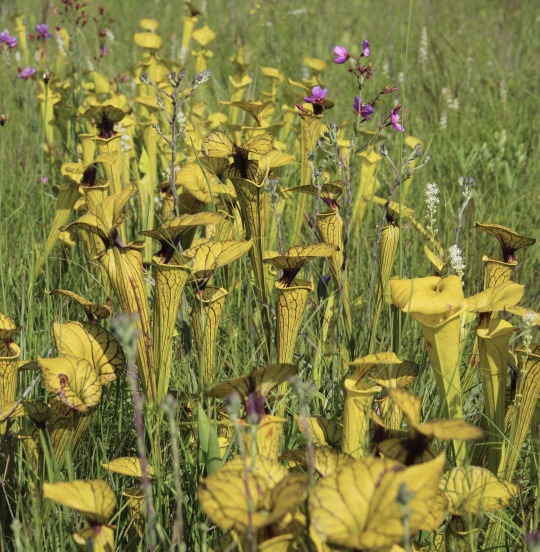
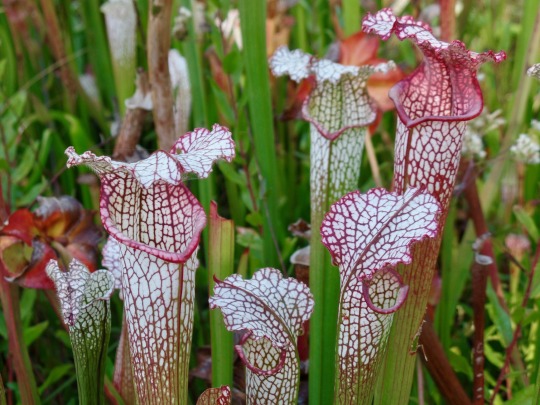




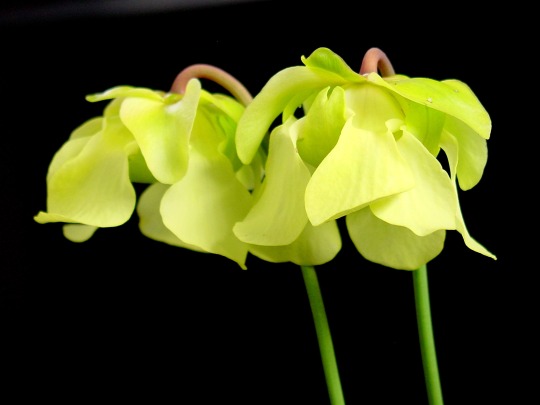
a brief selection of carnivorous plants from my critical role fic the gardener.
these are all north american species, mostly because that’s what I’m familiar with. but there are plenty I haven’t included, even within north america (like the bladderworts and butterworts), but especially further afield (tropical pitcher plants! carnivorous bromeliads! etc). there’s even been some recent research showing that a lot more plants may be carnivorous than we thought, as in the case of the western false asphodel.
photo credits below:
[tracy’s sundew / pink sundew / purple pitcher plant among sphagnum moss / yellow pitcher plant / white pitcher plant / thread-leaved sundew in bloom / mountain sweet pitcher plant in bloom / venus flytrap in bloom / white pitcher plant in bloom / pale pitcher plant in bloom]
important note: never collect carnivorous plants from the wild. make sure any carnivorous plant purchases are from a reputable source and have been cultivated ethically, not wild-poached.
14 notes
·
View notes
Photo



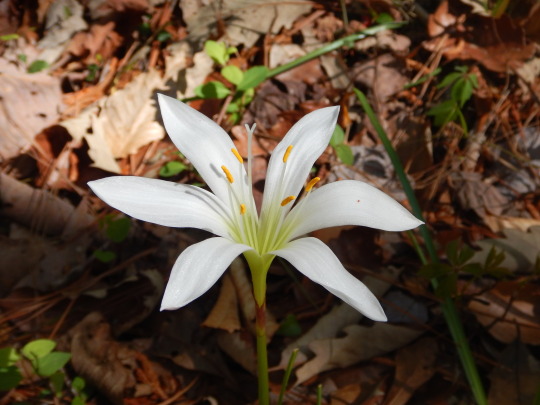



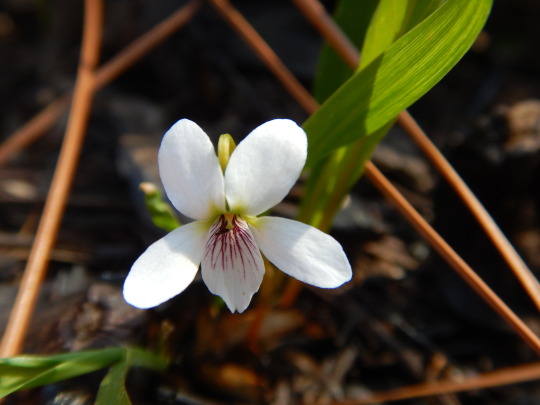


Some native spring flowers I’ve seen this year
Southern Blueflag - Iris virginica
Spurge Nettle - Cnidoscolus stimulosus
Jack-in-the-Pulpit - Arisaema triphyllum
Atamasco Lily - Zephyranthes atamasco
Cross Vine - Bignonia capreolata
Yellow Jessamine - Gelsemium sempervirens
Blue Butterwort - Pinguicula caerulea
Mountain Azalea - Rhododendron canescens
White Bog Violet - Viola lanceolata
Spotted Wakerobin - Trillium maculatum
#spring#wildflowers#iris#lily#aroid#trillium#native flowers#botany#botanist#nature#naturalist#vern's-pics#flowers
18 notes
·
View notes
Photo

Wildflowers of Eastern Greenland Greenland may not be green, but it the short summer period it explodes with wildflowers. Many bloom for a very short time - weeks or perhaps even days, almost all are small and close to the ground, if not miniature, but all are super showy and bright to attract the few pollinating insects that exist. There were many coming Arctic wildflowers like cottongrass or poppies or various saxifrages, but there were some quite rare finds like the carnivorous butterwort. All in all, there are 25 species collected in this post plus 3 types of berries. I hope it’s one of the more comprehensive lists of the Eastern Greenlandic flora, and my job as a botanist-at-heart is complete and done. The species pictures are Dwarf willow, Arctic cottongrass, Northern common cottongrass, Mountain sorrel, Alpine bistort, Arctic wintergreen, Arctic alpine fleabane White Arctic bellheather, Entireleaf Aven, Mountain aven, Drooping saxiflage, Alpine saxifrage, Tufted saxifrage, Purple saxifrage Yellow mountain saxiflage, Dward fireweed, Arctic mouseear, Moss campion, Arctic campion, Hairy lousewort, Alpine Cinquefoil, Common Butterwort, Showy Pussytoes, Mountain Harebell, Tundra Chickweed, Arctic Mouseear, Mountain crowberry, Bearberry, Bog Blueberry #travel2unlimited #travel #travelblog #arctic #arcticcircle #greenland #eastgreenland #oceanwideexp #expedition @oceanwideexp #flora #wildflowers (at Greenland) https://www.instagram.com/p/CiOip-0j-Rf/?igshid=NGJjMDIxMWI=
#travel2unlimited#travel#travelblog#arctic#arcticcircle#greenland#eastgreenland#oceanwideexp#expedition#flora#wildflowers
2 notes
·
View notes
Text
Cornwall’s Numerous Beautiful Flowers!
[The reporting numbers of flowers in Cornwall is roughly around 200 and this was the informational report that inspired the motions to create this fine arts printed matter. While the field working journeys took me to numerous different sites, I wasn’t counting the number of flowers that I was just photographing. Out of the potential 200 different flowers in Cornwall I only need appropriately 120 photographs. It’s funny, what was the initial constructing idea for this book it wasn’t what I ended up executing as the final design layout of this publication. Along the Cornish countryside some of the plants I saw along the banks of the waterways and almost everywhere are Wild Garlic, Yellow Iris, St John's-Wort, Dandelion, Cowslip and many others.
I noticed that throughout the Cornwall area many same species of plants are thriving in surrounding wildlife areas, cities, & townships, as such it’s very common to see all around the plants like Carline Thistle, Wild Daffodil, Burdock & Common Butterwort. Likewise, when you have travelled from locations to locations, you’ll also notice that many of the garden plant species that the Cornish locals are growing you’ll also have a similarity of abundance in the people’s gardens. Even after saying that, you’ll still find some unique plants amongst the local walking. Inland and the sea; there are some varieties of plant species that would only thrive in the Cornish inland areas while there are also some plant species that have found their places by the seaside.
The coordinates of 50.2660 degrees North N, & 5.0527 degrees West these are the nautical locations on the latitude and longitude for the amazing environmental area called Cornwall. The breath-taking waters that is the embodiment of summertime leisure and pleasures is none other than the Atlantic Ocean and for centuries it’s been the channelling waypoint to travelled from land to see to the Cornish side of England. The numerous flowers of Cornwall are just a literary appetizer, while my expanding creative interests and visual sights are to aid the production of more fine arts books in the durations of pursing higher educational accomplishments, such as studying and acquiring a Marine Conservation Diploma & an Environment Photography PhD degree.
I have lived in many areas of the UK, & I must say, it’s the first time in my life while here in the UK that I am seeing such an area teeming with so many different floral lives. When I was out and about in the Shetland Island of Scotland; yes, there were wild flowers around; however, not in the abundance as in Cornwall, and the extreme cold weather of Shetland made it uncomfortable & difficult to photographed. Even in the Cornish winter seasons, outside photography in Cornwall is a much warmer environment to be in, because my hands were not freezing burning cold while engaging in the journeying fieldwork for this publication. The terrain of Cornwall with its rich floral patterns produced a serene effect on the body, which caused smiling to occur.
This caused me to think, does flowers cause people to smile and the studies shows yes flowers does have an immediate impact on people’s happiness. I am very happy here in Cornwall and this flowery book can attest!]
L-Muur Press P3 PLAY! Journeying Fieldwork! Ne Plus Ultra!
JUS COGENS ERGA OMNES! SELF-DETERMINATION FLOWING TO ALL!
0 notes
Photo

Pinguicula lutea
Yellow Butterwort
(via)
28 notes
·
View notes
Photo

4 wee 5x5 inch paintings of lions, stars, and carnivorous plants.
[ID: a grid of 4 square paint pen and colored pencil illustrations. Each grid contains a brightly colored lion surrounded by stars and plants. From left to right, top to bottom: a blue horned lion surrounded by yellow stars with several sundew plants at its feet; a crouched red lion surrounded by blue stars and two butterwort plants near its feet; a seated yellow horned lion with one raised front paw surrounded by green stars, with a purple pitcher plant hovering over its back; a white prancing lion surrounded by red stars and flowering bladderwort plants.]
2K notes
·
View notes
Photo

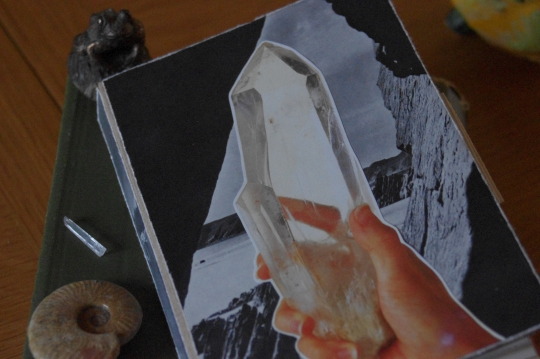




New Year’s Sale! 40% off selected items!!!!
Be quick, this sale ends on the 5th of January!
🌲 Dark Forest Woven Scarf was £20, now £12
❄️ Moss, Blood and Ice Woven Scarf was £20, now £12
🍂 Bitter Oysterling Junk Journal was £6.85, now £4.11
🍰 Vintage Cookery Junk Journal was £20, now £12
💜 Purple Crystal scrap pack was 75p, now 45p
💎 Crystals and Rocks Junk journal was £19.75, now £11.85
🦆 Bird Junk Journal was £25, now £15
🌿 Plant Illustrations (Primrose, Wood Sorrel and Butterwort) was £1, now 60p
🌼 Flower-y Mushroom badge was £4.50, now £2.70
🍄 Tawny Top Mushroom badge was £4.50, now £2.70
✨AND! If you spend £30 or more before postage you get a secret free gift!✨
Happy New Year Everyone!
#Scrap Pack#junk journal#scrapbook#scrapbooking#scarves#scarf#weaving#sewing#badge#mushroom#crystals#rocks#crystal witch#kitchen witch#cooking#vintage#cottagecore#naturecore#adventurecore#forestcore#Dirtcore#grandmacore#green witch#small artist#supportsmallbusiness#supportsmallmakers#supportautisticcreators#actuallyautistic#crafts for sale#weekendwizard
23 notes
·
View notes
Photo

Houseplant Heaven!
Clockwise from left:
BARBADOS CHERRY BONSAI MALPHIGIA GLABRA Textured bark and scented pink blooms in summer. Flowers are followed by edible red fruit.
MAXILLARIA TENUIFOLIA Orchid with grassy foliage on round pseudobulbs. Coconut-scented blossoms in spring.
STRAWBERRY BEGONIA SAXIFRAGA STOLONIFERA Begonia-like foliage and masses of trailing pink runners. Spikes of white blooms in late winter.
VARIEGATED BEAR PAWS
COTYLEDON TOMENTOSA VARIEGATA
Plump, fuzzy foliage, streaked with yellow. Serrated tips resemble claws. Orange, bell-shaped flowers.
HOYA NUMMULAROIDES
Super scented white blooms on fingernail-sized succulent leaves.
GIANT BUTTERWORT
PINGUICULA GIGANTEA
Carnivorous plant with fleshy foliage, covered in a fine mucous. Traps and eats fungus gnats and white flies. Pink flowers in spring.
by kims_nature
68 notes
·
View notes
Text
Carnivorous Plants and the Things I Know About Them
I've been kicking around the idea of making a post like this and I figured it was of enough general interest to folks on Tumblr to go for it.
So
One of the things I do is grow carnivorous plants, like these




From top left to bottom right we have a Venus Flytrap, a North American Pitcher Plant, a Sundew, and a Butterwort. All of these are pictures I've taken of plants during the growing season.
Now if you look at these weird looking plants you probably wouldn't expect them to be native to North America, but they are. You can find pitcher plants all over the southeast up to the northeast into Canada, flytraps in the Carolinas, and butterworts and sundews all over the continent.
These plants are a lot of fun and easy to grow once you understand their requirements, but before we get into that, I want to take a moment and explain how they came to be in the first place.
To keep it short, carnivorous plants are carnivorous because they grow in soils that are lacking in the nutrients plants need to put out new growth. Because of this, they evolved to find their nutrients a different way - by luring, trapping, and digesting insects. While these plants still photosynthesize, they supplement this with the nutrients they absorb from insects.
Now that we've got that out of the way, I'm going to go into the basics of growing them, point by point. A short disclaimer - I'm specifically talking about temperate North American plants, since they're what I have experience growing. I can provide basic info on how to take care of tropical plants like the southeast asian pitcher plants, but as of this post I don't have experience with them yet.
Soil: For carnivorous plants, a good soil mixture is a must. These plants grow in nutrient-poor marshes, and the soil they call home is constantly wet. The main ingredient in basically any carnivorous plant soil mix is sphagnum peat moss, which is slightly acidic. The second part of the mixture is often perlite or horticultural sand. Some nurseries use a mix of equal parts peat and perlite while others use 80% peat and 20% perlite, but I've had success with both. The most important thing to ensure is that your soil doesn't have any fertilizer added to it. Because carnivores grow in low nutrient soil, any kind of medium that contains fertilizer can actually kill them.
Water: The other vitally important part of the equation (and the one that kills lots of plants when incorrectly applied) is water. Generally, unless your tap water is soft, water carnivores with distilled or reverse osmosis water. The minerals in tap water or even bottled drinking water can eventually build up and kill your plant in the same way fertilized soil does. Carnivores love waterlogged soil, and some even get flooded in nature. To approximate this, set your plant in a tray of water no more than an inch or two high. This ensures your soil stays wet without having to constantly water it.
Containers: Plastic pots are your friend. Avoid terra cotta clay pots, since they can leech minerals into the soil and also tend to dry out your substrate faster. Glazed clay containers can also work. If you're using the tray system, make sure to buy pots with drainage holes, so the water can get in. Also, a trick that lets the water in but keeps the soil from escaping is to line the bottom of the pot with long-fibered sphagnum moss. If you go with an undrained container, make sure to keep the soil wet at all times, but allow some of the water to evaporate in order to keep the water table fluctuating.
Sunlight: Since carnivores evolved their leaves to catch insects, they're pretty poor at photosynthesis. As a result, these plants love sun - the more the better. Many a store bought flytrap has perished as a houseplant due to lack of sun, so if you can, put these plants outside, in the sunniest spot you can. Generally, it's good to give most carnivores around 6 hours of sunlight per day. Many can get by with 4, but they don't often thrive with that amount of light.
Dormancy: Plants that grow in temperate or warm temperate climates tend to buckle down and hibernate during the late fall and winter months, conserving energy until spring. Generally speaking, the large traps die off, or in some cases the plant dies down to the roots, or forms a small bud that rests on the ground. Plants grown outside respond to colder temperatures and shorter photoperiods, while plants grown inside usually need some help. If you're growing your plants on a windowsill or in a terrarium, move them somewhere cold or cut down on their heating, and also diminish the amount of daily light they receive. You can also slow down on watering, though they still need some water to get by.
Temperature: Temperate and warm temperate carnivores can tolerate a wide range of temperatures, despite what you might think. My pots survived the freak snowstorm the Pacific Northwest got this February without a single dead plant. Most species can tolerate temperatures up to 100 degrees Fahrenheit and down to 20 degrees, though not for prolonged periods of time. If you see long spells of hot or cold weather coming, try and move your plants to a protected area until they pass.
Feeding and Fertilizing: Now I know what you're thinking. Fertilizer? He just told us that stuff was death! And it often is, but there are ways to fertilize your plants. Generally, a fertilizer made for acid-loving plants can be diluted and applied to the leaves during the growing season. I use Maxsea 16-16-16 on plants that are too young to easily catch prey (diluted down to a half teaspoon per gallon) and haven't had issues. Try not to spray the soil unless you frequently water your plants from overhead, as the dreaded mineral buildup can still occur. That said, if your plants are outside, they'll fertilize themselves. You can also "feed" your plants insects using tongs - keep in mind that some plants require their prey to be alive in order to secrete digestive enzymes. I'll get into prey in more detail in other posts about specific types of plants.
Flowering and Propagation: For a lot of carnivorous plants, flowering is an exhausting effort that tends to deplete the energy they would use creating traps. As a general rule, if you're not interested in seed, clip the flower stalks off. Many plants can be propagated through leaf or root cuttings, which produce genetically identical plants. Some plants also clump and form their own divisions over time, meaning all you need to do to get more is wait for a year or so, depending on the age of the plant.
Pests: Carnivores can be targeted by various pests. For insecticides, I've seen neem oil recommended, as its generally less harmful to the plant and the environment. I haven't had to make much use of these yet, so my information on insecticides is a bit of a blind spot. Generally, try and stay away from soap insecticides and aerosols, and stick to less concentrated varieties. If you're dealing with squirrels or rodents digging up your plants, I found a generous sprinkling of cayenne pepper around the plants works wonders, and does no harm to the plants.
This is a basic rundown of carnivorous plants and how to take care of some of them. I must stress there's a ton of information out there - this post is geared more towards starter plants that are fairly forgiving and simple to grow.
So why grow carnivorous plants when you can just go out and buy some petunias?
They're active: Carnivores are showy, unique plants that can move on their own through some incredibly unique and complex evolutions. Watching a Venus Flytrap snap shut or a Sundew curl around an insect is a truly special thing to see.
They're a conversation piece: The relative rarity of carnivores in cultivation means the average person doesn't know much about them, despite maybe having heard of a Venus Flytrap before. A 12" pot of flytraps, sundews, and pitchers is a surefire way to grab attention.
They can control certain pests: Carnivorous plants can act as natural pest controllers. North American Pitcher Plants gorge themselves on flies and wasps, and considering some pitchers can grow over two feet tall, they can hold plenty of them. Sundews and butterworts specialize in catching smaller prey, such as fungus gnats, fruit flies, and even fleas. These plants can work as limited, natural pest controllers, though they won't eradicate a yellow jacket nest for you.
They're endangered in the wild: The wet, marshy habitats carnivores call home are rapidly dwindling due to improper land management and development. Some are nearly extinct in their home ranges, kept going through dedicated nurseries and attempts to naturalize them in other locations. By caring for carnivorous plants, you're raising awareness of these unique, underappreciated organisms and aiding in their conservation by keeping them alive.
Phew, I realize this was a lot, but I hope it was a fun read! Let me know what you think about carnivorous plants, or if you have any questions about them. I'm going to try and go into more detail on specific plants later, but for now, I wanted to bang out the basics.
If you're looking for more information, Flytrapcare.com is a great forum, and the r/savagegarden subreddit is very helpful as well. For books on the subject, the Savage Garden by Peter D'Amato is the go to source. Nurseries I've used and can vouch for are Sarracenia Northwest (located in Oregon) and California Carnivores (located in California).
25 notes
·
View notes
Photo

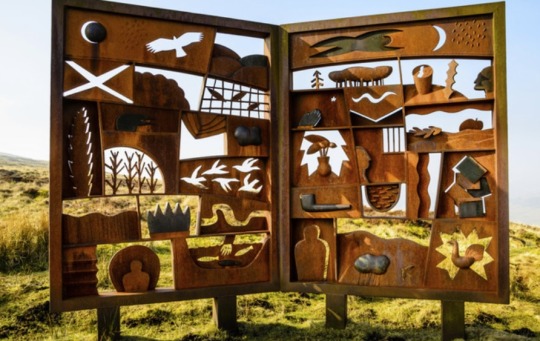
On 11th August 1892 poet Christopher Murray Grieve was born in Langholm.
C M Grieve, or Hugh MacDiarmid as he is better known, was a journalist and writer of poetry and prose. He is now recognised as the principle force of the Scottish Literary Renaissance, a movement which radically altered the landscape of Scottish writing in the first half of the 20th century.
MacDiarmid worked as a journalist prior to the outbreak of the first world war, and in 1914 he was appointed to serve in the Royal Army Medical Corps in Salonica, Greece and France. He developed cerebral malaria in 1918 and was sent back to Scotland to recover. Two of his poems, Another Epitaph on an Army of Mercenaries and At the Cenotaph, angrily refute the notion of war as anything but futile.
After the war, he continued to work as a journalist and spent most of the 1920s living in Montrose, where he became chief reporter at the local paper. He was later appointed Justice of the Peace and a member of the county council.
After a time living in the remote Shetland island of Whalsay he moved to a cottage (with little in the way of comfort) near Biggar. Although never having made much of a living through his work he was much admired and his political beliefs saw him travelling to the old USSR and China.
MacDiarmid was interested in language and came to believe that the Scottish psyche could not be expressed in the English language alone, and had to be developed and written in a synthetic Scots to achieve a coherent national voice. He began to evolve a synthetic Scots gathered from many regional variants, and to reclaim archaic language which, once used by the Makars, had fallen from use.
For a man not keen on sentimentality he had a deep felt love for Scotland and wasn’t shy in showing where he belonged by wearing the kilt often.
There is a memorial to MacDiarmid just north of Langholm. It takes the form of a giant book and was designed by sculptor Jake Harvey as seen in the second pic.
Scotland Small?
Scotland small? Our multiform, our infinite Scotland small?
Only as a patch of hillside may be a cliché corner
To a fool who cries ‘Nothing but heather!’ where in September another
Sitting there and resting and gazing around
Sees not only the heather but blaeberries
With bright green leaves and leaves already turned scarlet,
Hiding ripe blue berries; and amongst the sage-green leaves
Of the bog-myrtle the golden flowers of the tormentil shining;
And on the small bare places, where the little Blackface sheep
Found grazing, milkworts blue as summer skies;
And down in neglected peat-hags, not worked
Within living memory, sphagnum moss in pastel shades
Of yellow, green, and pink; sundew and butterwort
Waiting with wide-open sticky leaves for their tiny winged prey;
And nodding harebells vying in their colour
With the blue butterflies that poise themselves delicately upon them;
And stunted rowans with harsh dry leaves of glorious colour.
‘Nothing but heather!’ ̶ How marvellously descriptive! And incomplete!
8 notes
·
View notes
Text
Using this time wisely
The Environmental Interpretation program offered by FMNP I signed up for was canceled due to this virus outbreak, so I am using this time to teach myself.
I purchased quite a few books on interpretation.
Applied Interpretation: Putting Research into Practice
Management of Interpretive Sites: Developing Sustainable Operations Through Effective Leadership
Interpretive Writing
I thrive and survive…
View On WordPress
0 notes
Text
Blue Bird Day Climb
By Mike Wilkes
A burn meanders across the valley, swinging to and fro within the cradle of the glens parabolic walls. Buttery, yellow sunshine warms the bog and heather, raising drifts of Large Heath butterflies from the banks. The track steepens, the effort bringing on an eye-stinging, itchy-wool hotness. Exertion narrows focus to only the next foot fall. Boggy ground, the occasional purple butterwort, then coarse, dry heather, then Wooly Fringe Moss, now Creeping Azalea and rock. Now only shards of sandpaper-rough quarzite as the gradient eases slightly. The air at this height is rinsed by a chill breeze, as if from space, and it is menthol to the lungs. Then crack, the crest. Like plunging into a blue-black ocean that hangs above a sandy, mauve seabed. The ground falls away to the view of Munros - Cairn Toul, Braeriach, Ben Macdui and sky.
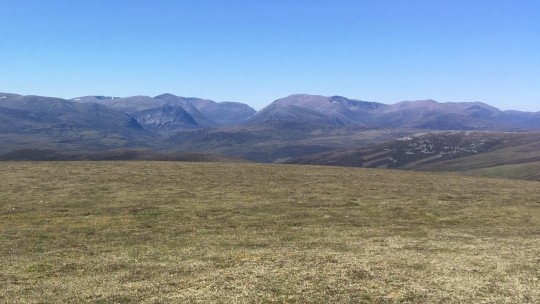
1 note
·
View note